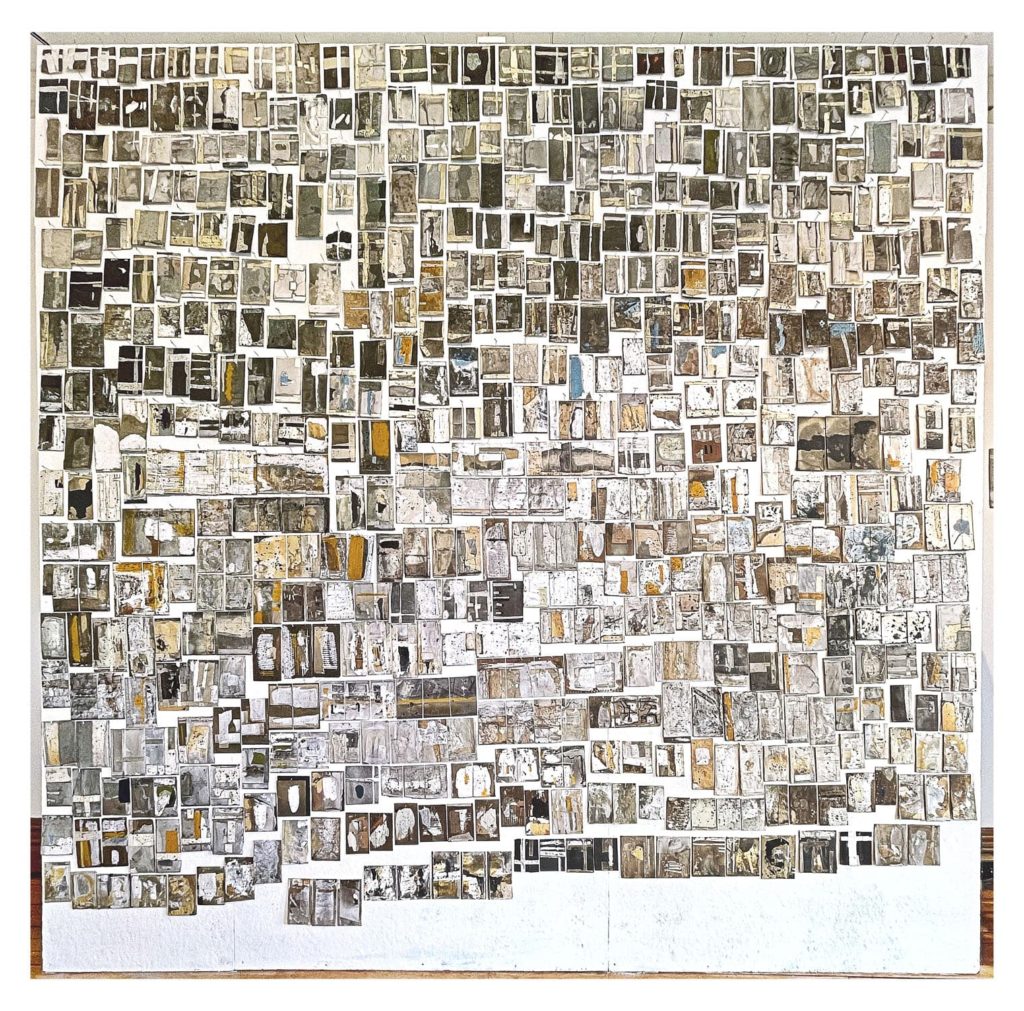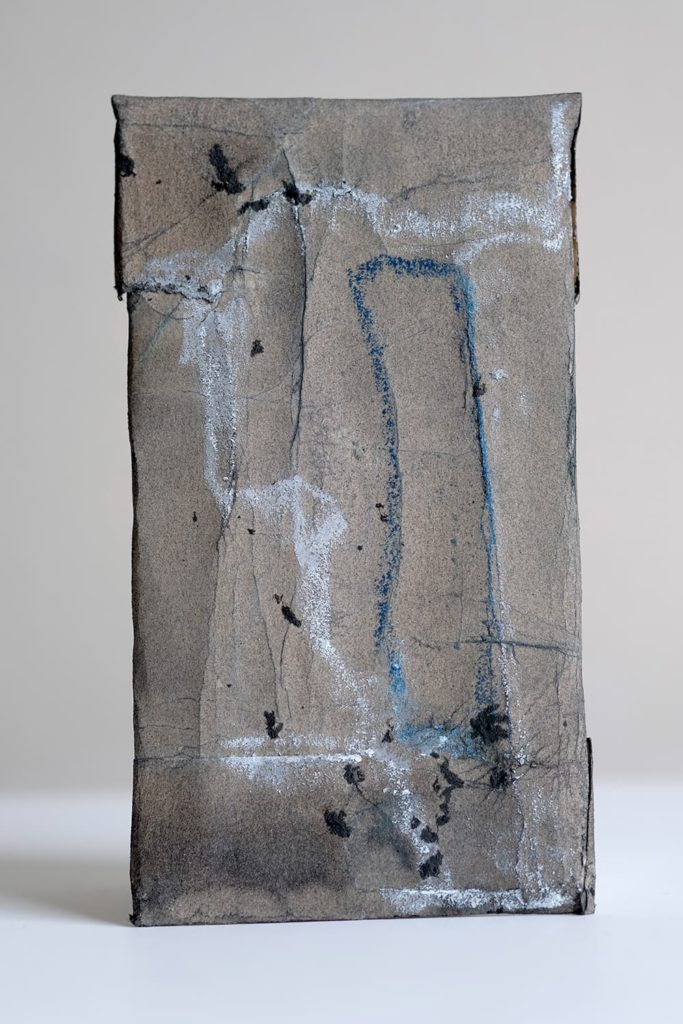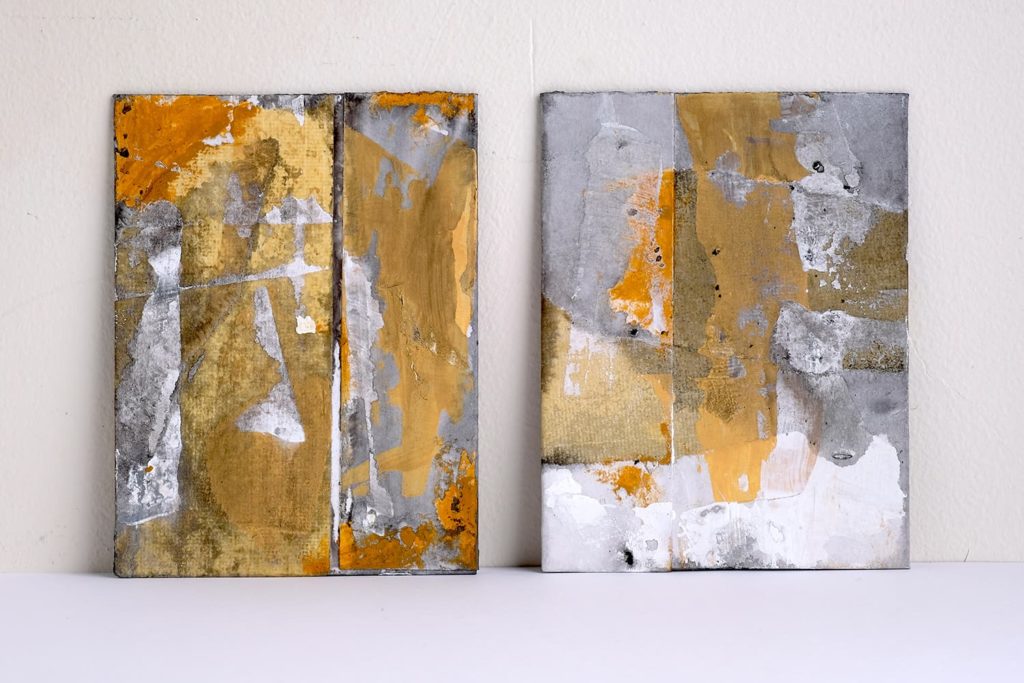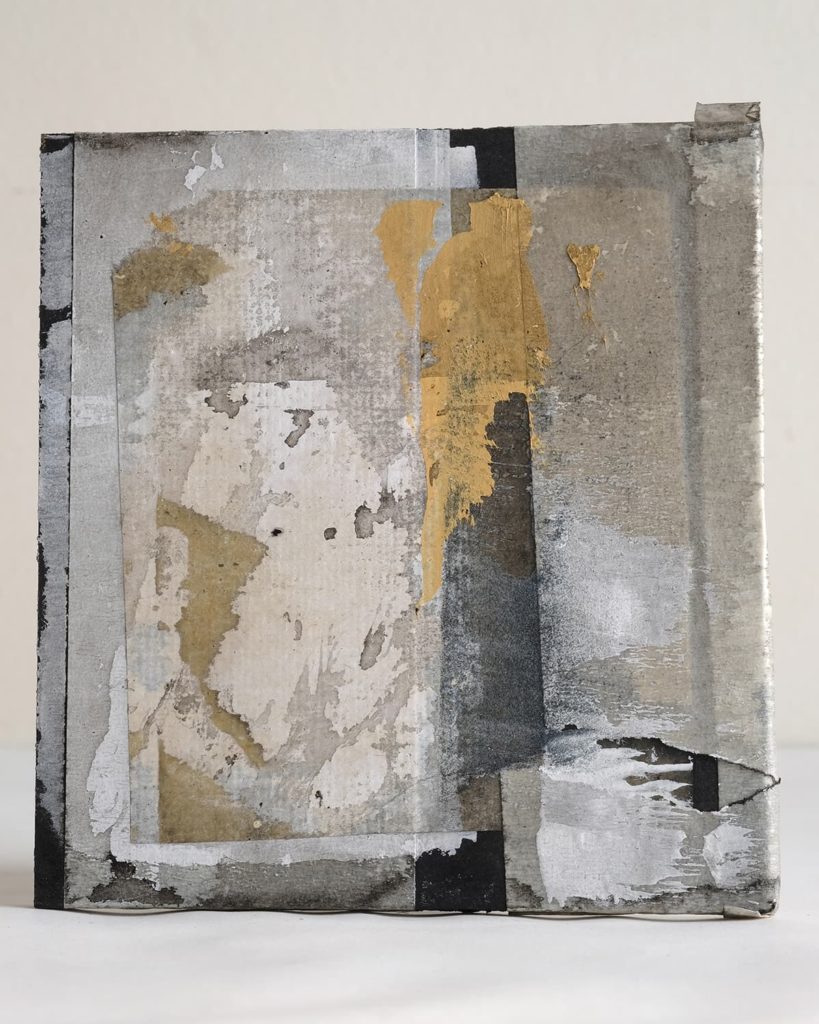AB –How did you come to begin making the mixed-media works in the series Gratitude in a Time of Loss that you have been creating for the last several years?
DB –The very first “package” was a process experiment, kind of a distraction while trying to finish a body of work for an imminent solo show. I folded a piece of washi paper then wrapped it with tape to hold it together so I could soak it in a diluted sumi ink bath, thinking it might produce an interesting pattern on the paper once unfolded.
Upon taking it out of the bath I was struck by the little package. I found it so unexpectedly beautiful I was reluctant to unwrap it. When I did stick to my plan and undid it, I wasn’t impressed with the results…just gray paper with no real pattern. So, I decided to make a new one and let it dry intact.
I loved it. I made more.
After making 20 or so, I was still intrigued with the variations. They felt like little miraculous gifts. I was finding solace in them, without really knowing why, but I was also still trying to finish the series of work for the fast approaching solo show. I started second guessing why I was spending time on these…what they were all about. I was posting photos of them on Instagram, and quite a few people asked to buy them, but I found myself saying no, thinking there was something important about them all being together.
On a long walk one night, I was thinking about them, wondering if I was being self-indulgent in making so many, probably 30 or so at that point. It seemed to me that they were related to Covid and I was grateful for the comfort I was finding in making them. I wondered if there could be a stronger connection. Then it occurred to me that at that time there had been 60 covid deaths recorded here in Vermont. If I wanted to make one for each person, I was half way there. It felt immediately right.
Unfortunately It was right about that time that the Covid numbers rose and so did the deaths, so it took me till New Year’s Eve to actually catch up to the growing total. Since then I’ve checked each day and stayed current. This past week the total has risen to 648.


AB –How has the project changed or evolved over its two-year span?
DB –The pieces in the series certainly grew more complex, and sometimes colorful, in the course of the two-plus years that I’ve been making them. I remember that it became particularly difficult in January of 2021. I’d finally caught up with the increasing pace of deaths in Vermont on New Year’s Eve, and found myself waiting each morning to see if there would be any new deaths, and therefore, new pieces to make. Daily updates were posted at 11 am by the Department of Health, so a kind of ritual evolved of sitting in my studio sipping coffee and waiting to hear the news.
Some days there would be up to six new deaths reported, and it would feel like a body blow. It was during this time that I started to add some color. It was an intuitive gesture, more a relief for my eyes and a distraction for my hands than a conscious, meaningful signal. In any case, it helped.
AB –Do you feel a personal connection with the people you commemorate each day, whom you may know only as a statistic?
DB –I don’t have a personal connection to anyone who has died here in Vermont from Covid. While it’s accurate, I’m not sure “know only as a statistic” feels quite right either. During a show in March of 2021, I had a visit from a woman whose husband had died from Covid the previous December. She shared that fact only after we’d talked for an hour or so about the series and my other work, which also addresses many of the same themes. I confessed to her that I’d been worried that my pieces could be construed as insensitive or presumptuous. Her reassurances were a great comfort to me, and I think also opened me up to some freer exploration of aesthetic beauty in these works.

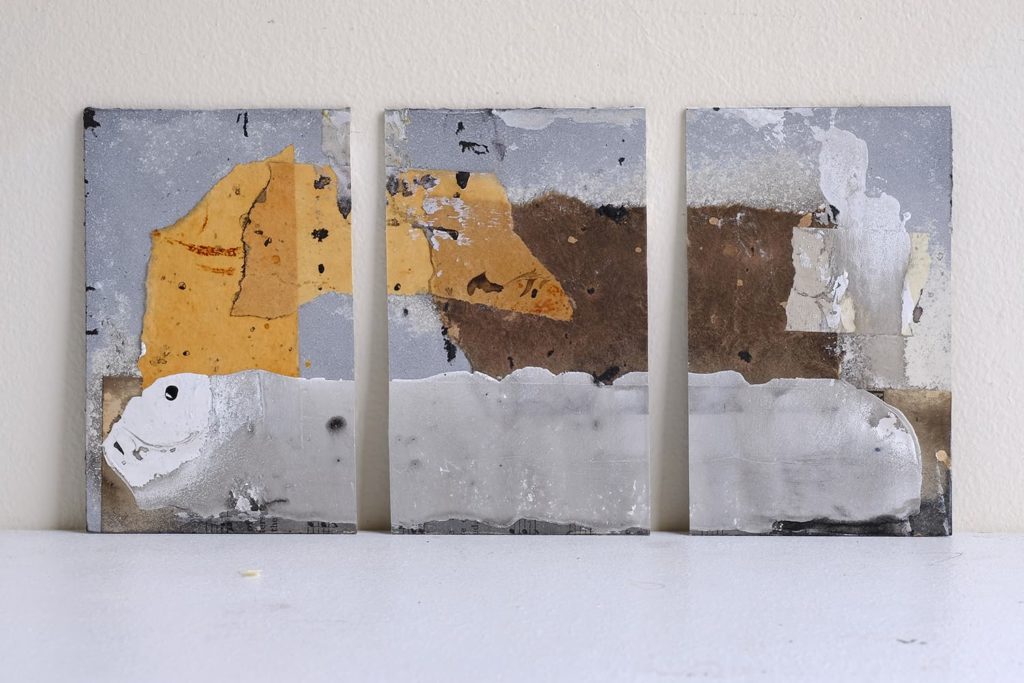
Daryl Burtnett, Gratitude in a Time of Loss #448, 450, 451, mixed media, 2020-2022
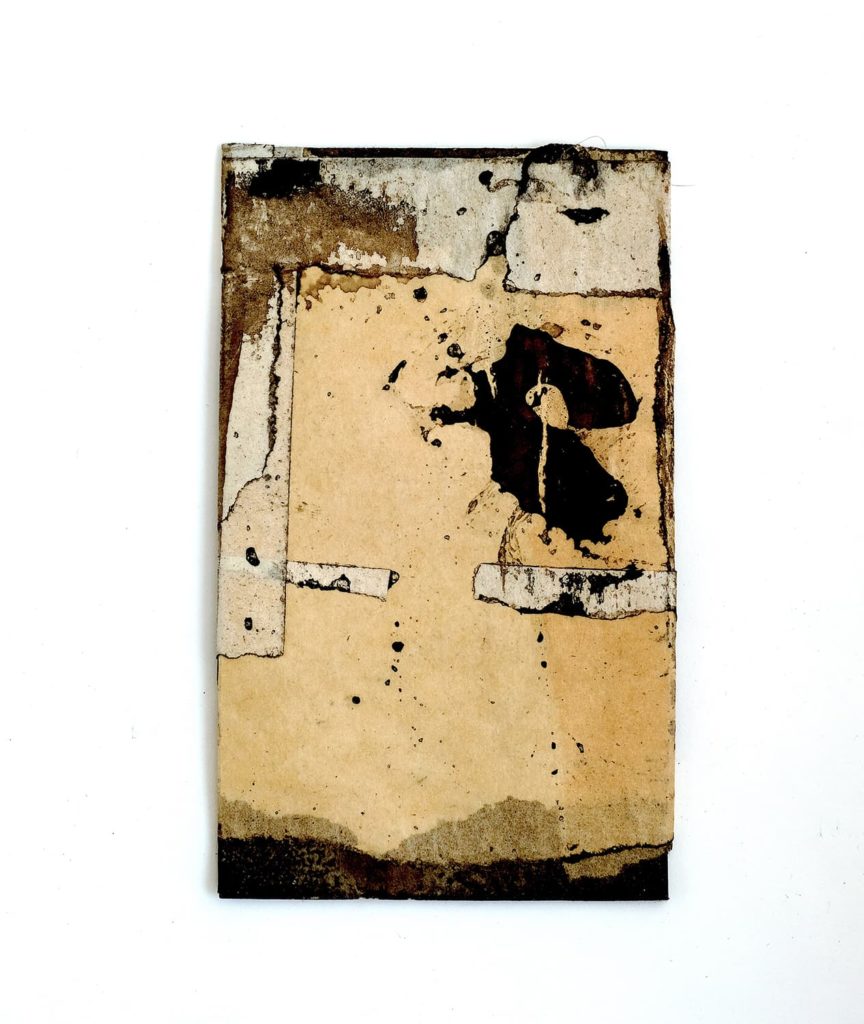
AB –In your videos on Instagram, which I recommend readers check out to learn more about your process, you show how a work from this series might begin, and the choices that you make throughout the steps. What guides this process?
DB –My process, especially early on in the series, has been mostly intuitive. The pieces are small, fit in the palm of my hand, and so I begin them mostly by feel. I leave each day’s materials out on my table, and often one day’s torn bits or drying paper find their way into the next day’s piece. I decided early on that each piece would have a last step of being bathed in a pan of ink. That ink bath has been replenished, and even re-constituted, after drying to crust many times, but it’s carried on kind of like a sourdough starter. I admit there have been moments of doubt when I’ve really loved a piece before the ink bath and mourned a bit the loss of the earlier state, but that seems fitting too.
AB –Each piece in this series is unique and compelling on its own, but installed together, the works become a mass, a testament to the weight of the loss of human lives. Do you think differently about the separate components of this work versus its impact as an installation?
DB –I do. Even though I decided early on that I wanted these pieces to be installed together, I would live with individual pieces out in view for days, sometimes weeks, before arranging them in their chronological sequence on large foam core boards. While sitting out alone or in small groups, I’d often pick them up and look closely. The push-pull of ink on oil or wax paper and tape meant each package/piece felt like a work in its own right. In their arrangement on the boards, I began to get a sense of ebb and flow, too.
It wasn’t until I mounted the current show that I got to see them all together, and that was something of a revelation. Even though the installation has been up for a month I’m still seeing new patterns and relationships among the pieces. Tomorrow, I’ll be taking them all down, which I expect will be another new way to feel about them, about it.
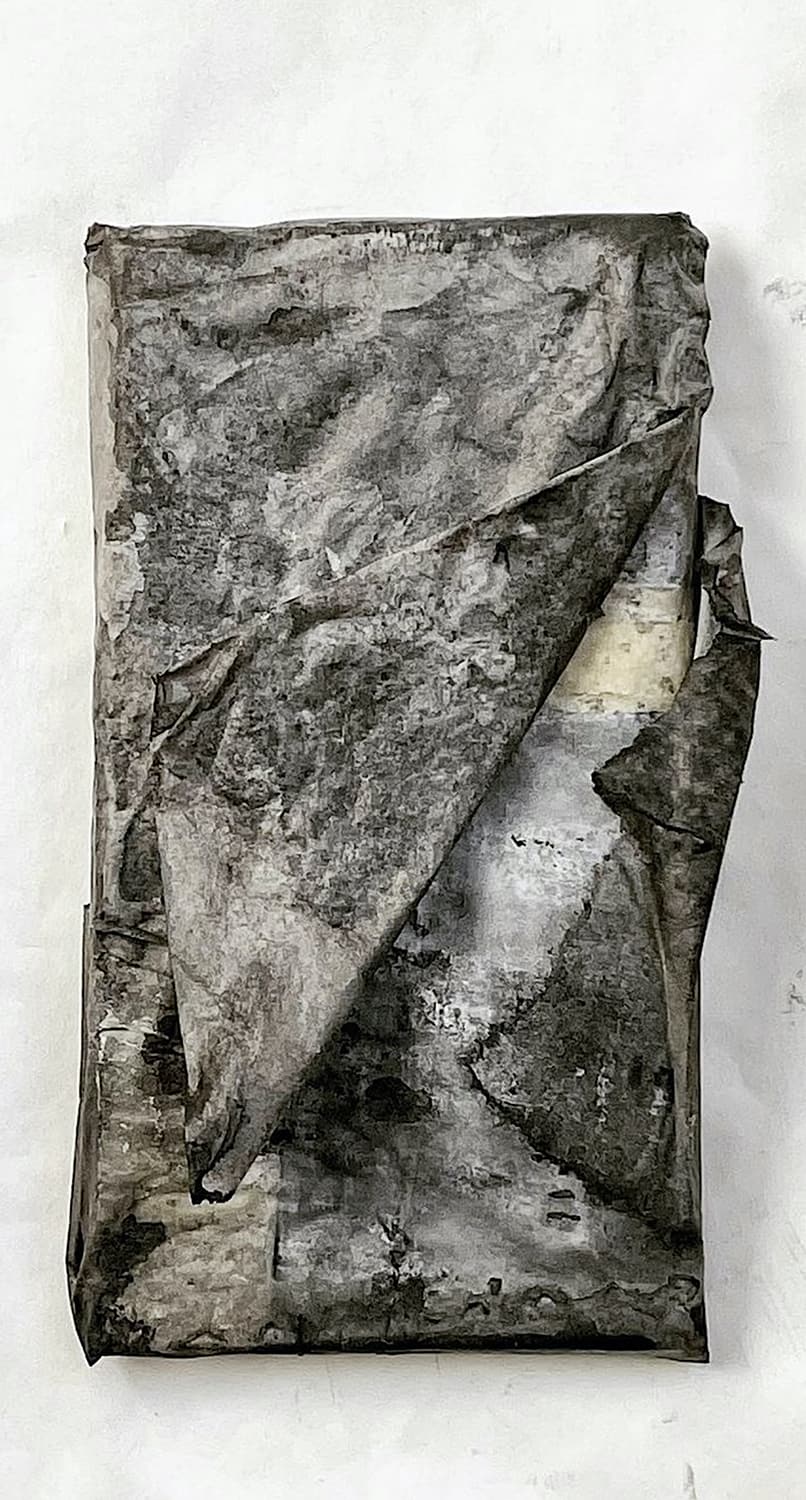
AB –You’ve described these works as packages and gifts, while they also seem to function as small monuments. What impact do you hope these works have on viewers?
IDB – hope they bring solace, and a sense that we’re less alone than we might feel sometimes.
AB –In an article from 2019 you describe one of the motivations of your work as, “responding to things that are beautiful, even as we face their loss.” Can you share more about how change and loss inform your ideas of beauty?
DB –This reflects a few pivotal moments of loss in my personal experience, one a tragic fire in a dormitory when I was in college, another the loss of my father, along with other less dramatic but life changing events around relationships. When I allowed myself to sit still with those memories, or in the case of my father, to actually sit still with him on the day he died, there were moments of beauty that didn’t obscure the pain, but were perhaps sharpened by it. I’ve come to believe that accepting the pain of loss without looking away is, for me, an essential part of experiencing the love and solace that make grief bearable.
AB –What are you planning next?
DB –I have a group show in July and need to make work for that. I’m still making these packages each day a Vermont Covid death is tallied, but I suppose I need to figure out how and when to stop. I’ve tried a few times, but it keeps not working.
Find more about Daryl Burtnett on his Instagram
